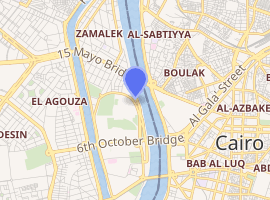Prince Amr Ibrahim Palace
The Prince Amr Ibrahim Palace is a historical building in Cairo's Zamalek island, which is used as the Egypt's first ceramics museum and as an art center.
| Prince Amr Ibrahim Palace | |
|---|---|

| |
| General information | |
| Architectural style | Neo-Ottoman |
| Town or city | Zamalek |
| Country | Egypt |
| Completed | 1921 |
| Cost | 200 million Euros ($257m) |
| Client | Prince Amr Ibrahim |
| Technical details | |
| Size | 850 square meters |
| Design and construction | |
| Architect | Garo Balyan |
History and location
The palace is located in the Gezira area, an island in the Nile, of Zamalek in Cairo.[1] It was built on the orders of Prince Amr Ibrahim (1903–1977), member of the Muhammad Ali dynasty, in 1921.[2][3][4] The architecture of the building was Garo Balyan, the youngest member of the Balyan family.[5] The cost of the construction was about 200 million euros ($257 million).[3]
The palace was used by the Prince as a summer residence.[6][7]
Style and layout
The architectural style of the palace is of neo-Ottoman[8] and of the neo-Islam.[9] It also reflects dominant styles of the Muhammad Ali dynasty in terms of its architectural and decorative style.[10] There are also Moroccan and Andalusian influences in the architecture of the palace.[9]
Total area of the building is 850 square meters.[6][11] It is made of a basement and two floors.[6] In the entrance hall there is a marble fountain decorated with blue ceramics.[1] The palace is surrounded by a 2,800 square metre garden.[12]
Current usage
The palace became a state property on 9 November 1953 following the coup in Egypt.[8][13][14] It was first employed as a club by the Arab Socialist Union until 1971.[15] From 1971 the building was employed by the Ministry of Culture as an exhibition gallery for the paintings endowed by Mohammed Mahmoud Khalil.[12] In 1998 it was renovated by the Egyptian architect Aly Raafat[6] and began to be used a ceramics museum in February 1999.[15] Then it became an art center, called El Gezira art center, also in 1999.[1][16]
References
- El Aref, Nevine (4–10 March 1999). "Take some steps back in time". Al Ahram (419). Archived from the original on 21 May 2008. Retrieved 24 July 2013.
- "Famille Souveraine". Egypt e dantan. Retrieved 24 July 2013.
- "Egypt: The return of the King?". Al Jazeera. 8 July 2013. Retrieved 24 July 2013.
- "Museum of Islamic Ceramics: Beautiful Browsing for the History-phobes". Cairo 360. 17 March 2010. Retrieved 24 July 2013.
- Raafat, Samir. "Cairo's belle époque architects 1900 - 1950". EGY. Retrieved 24 July 2013.
- "Museum of Islamic Ceramics". Egypt Holidays Diractory. Retrieved 24 July 2013.
- Jonathan M. Bloom; Sheila Blair (2009). The Grove Encyclopedia of Islamic Art and Architecture. Oxford University Press. p. 49. ISBN 978-0-19-530991-1. Retrieved 13 September 2013.
- Samir Raafat (4 February 1999). "The Palace of Prince Amr Ibrahim". Cairo Times. Retrieved 24 July 2013.
- Mohamed Ahmed Abdelrahman Ibrahim Enab (Winter 2019). "Saray of Prince Amr Ibrahim in Zamalek Archaeological and documental study in the light of a new document published for the first time". Journal of General Union of Arab Archaeologists. 20 (1). Retrieved 28 July 2020.
- "Gezira Art Center". DI-EGY Festival. 2013. Retrieved 24 July 2013.
- "Architecture in Egypt". MIT. Retrieved 24 July 2013.
- Yasser Talaat (23 February 1999). "Middle East's First Museum of Islamic Ceramics". Inter Press Service. Cairo. Retrieved 28 July 2020.
- "History of Zamalek". Zamalek 101. Retrieved 13 September 2013.
- Matthew Carrington (10 November 2008). Frommer's Egypt. John Wiley & Sons. p. 82. ISBN 978-0-470-40343-3.
- "The China syndrome". Al Ahram Weekly (557). 25–31 October 2001. Archived from the original on 13 September 2009. Retrieved 24 July 2013.
- Tomoe Murakami (October 2014). "Cosplay Report from Egypt". Wochi Kochi Magazine. Retrieved 28 July 2020.